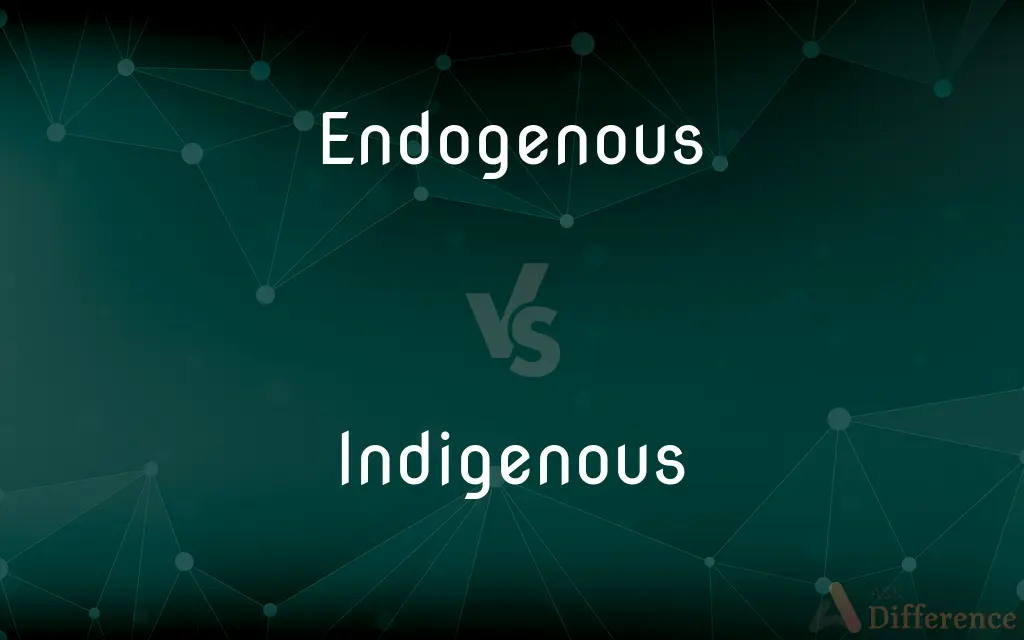Endogenous vs. Indigenous — What's the Difference?
By Tayyaba Rehman & Fiza Rafique — Updated on March 19, 2024
Endogenous pertains to something originating from within an organism, system, or process. Indigenous refers to people, plants, or animals native to a particular place, not introduced from elsewhere.

Difference Between Endogenous and Indigenous
Table of Contents
ADVERTISEMENT
Key Differences
Endogenous factors or processes are those that originate from within an organism, system, or geographical area, emphasizing internal sources of development or influence. For example, endogenous growth in economics refers to growth driven by internal factors rather than external influences. Whereas indigenous pertains specifically to the native species of a particular region or the original inhabitants of an area, highlighting their intrinsic connection and adaptation to their environment over generations.
Endogenous is a term broadly applied across various disciplines, including biology, where it might describe internal processes like hormone production, and economics, where it could refer to internal economic growth factors. Indigenous, however, is primarily used in ecological and cultural contexts, identifying species that have evolved in a specific location or peoples who have historical ties to a region, distinguishing them from those that are introduced or colonized.
The concept of endogeneity implies a focus on internal dynamics and mechanisms that propel change or development from within a system. This contrasts with exogenous factors that come from outside the system. On the other hand, being indigenous emphasizes a historical and natural belonging to a place, often involving a deep understanding and co-evolution with the local environment and culture.
In practice, endogenous processes or factors can influence the characteristics or development of a system in a way that is often predictable based on internal logic or mechanisms. Indigenous knowledge or biodiversity, however, represents a unique adaptation to local conditions, embodying a rich legacy of interaction with the environment that can offer invaluable insights into sustainability and conservation.
Endogeneity and indigeneity both play critical roles in their respective contexts. While the former is key to understanding the inherent capabilities or influences within systems, the latter is crucial for recognizing the value of native cultures and ecosystems, advocating for their preservation and respect.
ADVERTISEMENT
Comparison Chart
Definition
Originating from within an organism or system.
Native to a particular place, not introduced.
Application
Biology, economics, psychology.
Ecology, anthropology, cultural studies.
Focus
Internal factors or processes.
Native species or peoples and their environments.
Key Characteristics
Internal dynamics, self-driven processes.
Historical ties, adaptation to local conditions.
Purpose
Understanding intrinsic development mechanisms.
Preserving native cultures and natural ecosystems.
Compare with Definitions
Endogenous
Driven by internal factors in a system.
The company's growth was attributed to endogenous innovation.
Indigenous
Belonging naturally to an environment.
Indigenous knowledge is vital for sustainable living.
Endogenous
Originating from within an organism.
Endogenous hormones regulate various bodily functions.
Indigenous
Native to a specific location.
Indigenous plants often require less water and maintenance.
Endogenous
Inherent to an organism's functioning.
Endogenous rhythms dictate sleep patterns.
Indigenous
Original inhabitants of an area.
Indigenous peoples have unique cultures and languages.
Endogenous
Internal processes influencing development.
Endogenous variables significantly affected the study's outcome.
Indigenous
Not introduced or colonized.
The museum displays artifacts of indigenous art and craftsmanship.
Endogenous
Generated from within a geographical area.
Endogenous economic factors contributed to the region's prosperity.
Indigenous
Developed or occurring naturally in a region.
The conservation area protects indigenous wildlife.
Endogenous
Originating internally.
Indigenous
Born or originating in, native to a land or region, especially before an intrusion.
Endogenous
Originating or produced within an organism, tissue, or cell
Endogenous hormones.
Indigenous
Originating or occurring naturally in a particular place; native
The indigenous peoples of Siberia
Coriander is indigenous to southern Europe
Endogenous
Produced, originating or growing from within.
Indigenous
Originating, growing, or produced in a certain place or region.
Endogenous
Of a natural process: caused by factors within the body.
Indigenous
Being a member of the original inhabitants of a particular place.
Endogenous
Increasing by internal growth and elongation at the summit, instead of externally, and having no distinction of pith, wood, and bark, as the rattan, the palm, the cornstalk.
Indigenous
Of, belonging to, or characteristic of such inhabitants.
Endogenous
Originating from within; increasing by internal growth.
Indigenous
In particular, of or relating to a people (or their language or culture) that inhabited a region prior to the arrival of people of other cultures which became dominant (e.g., through colonialism), and which maintains a distinct culture.
The Ainu are the indigenous ethnic group of Japan's Hokkaido Island.
Endogenous
Of or resembling an endogen
Indigenous
Innate, inborn.
Endogenous
Derived or originating internally
Indigenous
Native; produced, growing, or living, naturally in a country or climate; not exotic; not imported.
Negroes were all transported from Africa and are not indigenous or proper natives of America.
In America, cotton, being indigenous, is cheap.
Indigenous
Native; inherent; innate.
Joy and hope are emotions indigenous to the human mind.
Indigenous
Originating where it is found;
The autochthonal fauna of Australia includes the kangaroo
Autochthonous rocks and people and folktales
Endemic folkways
The Ainu are indigenous to the northernmost islands of Japan
Common Curiosities
Can something be both endogenous and indigenous?
While they pertain to different concepts, certain aspects, like biodiversity, can be influenced by endogenous factors within an indigenous context.
Are endogenous factors always beneficial?
Not necessarily; endogenous factors can also contribute to negative outcomes, such as diseases.
How do indigenous rights relate to conservation?
Indigenous rights are crucial for conservation efforts as indigenous peoples play a key role in protecting their ancestral lands and the biodiversity within them.
What is an example of an endogenous process in economics?
Endogenous growth theory, which suggests that economic growth is primarily influenced by internal factors such as human capital, innovation, and knowledge.
Why is preserving indigenous cultures important?
Preserving indigenous cultures helps maintain cultural diversity, ensures the survival of unique languages and traditions, and contributes to the global heritage.
How do endogenous variables differ from exogenous variables in research?
Endogenous variables are those influenced within the model being studied, while exogenous variables come from outside and are not affected by the model's dynamics.
What role do indigenous peoples play in environmental conservation?
Indigenous peoples often have a profound understanding of their local environment, contributing to conservation through sustainable practices and knowledge passed down through generations.
What challenges do indigenous communities face today?
Indigenous communities often face challenges such as loss of land, cultural assimilation, environmental degradation, and violations of their rights.
Can invasive species become indigenous over time?
No, invasive species are considered non-native and can disrupt local ecosystems, whereas indigenous species are those that have originated and evolved in a specific location.
How can endogenous factors affect mental health?
Endogenous factors, such as genetics or brain chemistry, can significantly influence one’s susceptibility to mental health disorders.
Share Your Discovery

Previous Comparison
Enunciate vs. Articulate
Next Comparison
Aeviternity vs. AevumAuthor Spotlight
Written by
Tayyaba RehmanTayyaba Rehman is a distinguished writer, currently serving as a primary contributor to askdifference.com. As a researcher in semantics and etymology, Tayyaba's passion for the complexity of languages and their distinctions has found a perfect home on the platform. Tayyaba delves into the intricacies of language, distinguishing between commonly confused words and phrases, thereby providing clarity for readers worldwide.
Co-written by
Fiza RafiqueFiza Rafique is a skilled content writer at AskDifference.com, where she meticulously refines and enhances written pieces. Drawing from her vast editorial expertise, Fiza ensures clarity, accuracy, and precision in every article. Passionate about language, she continually seeks to elevate the quality of content for readers worldwide.















































